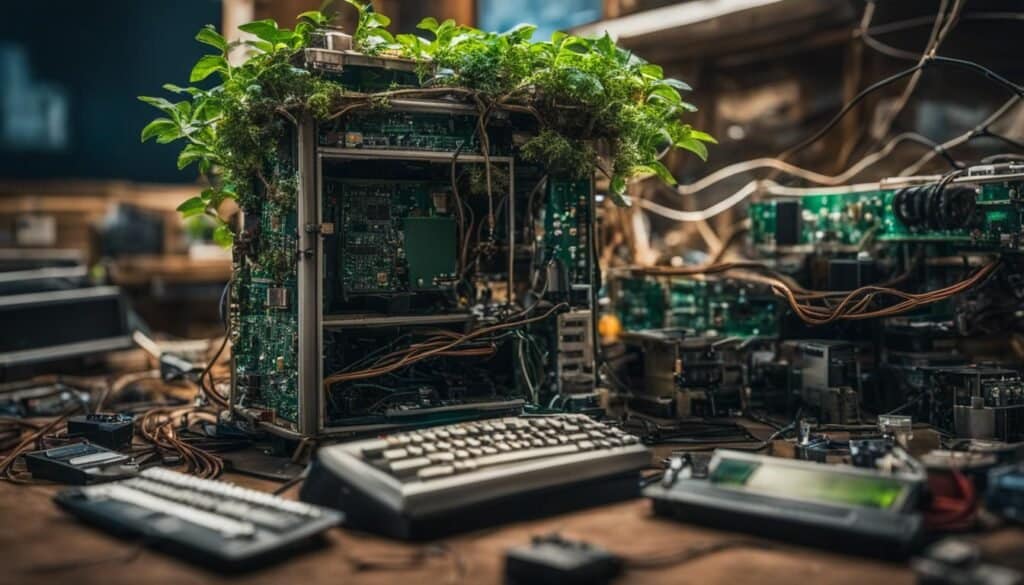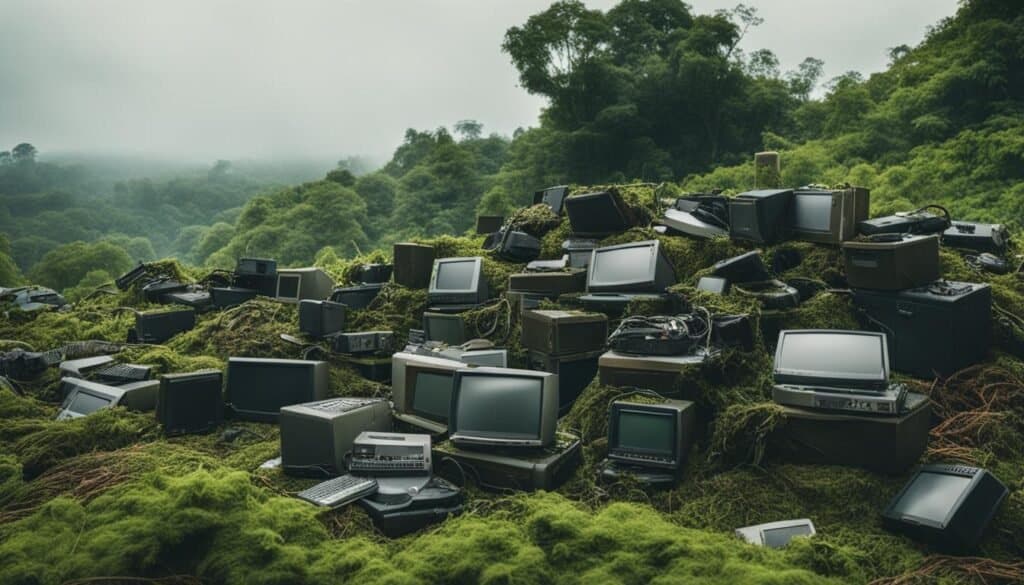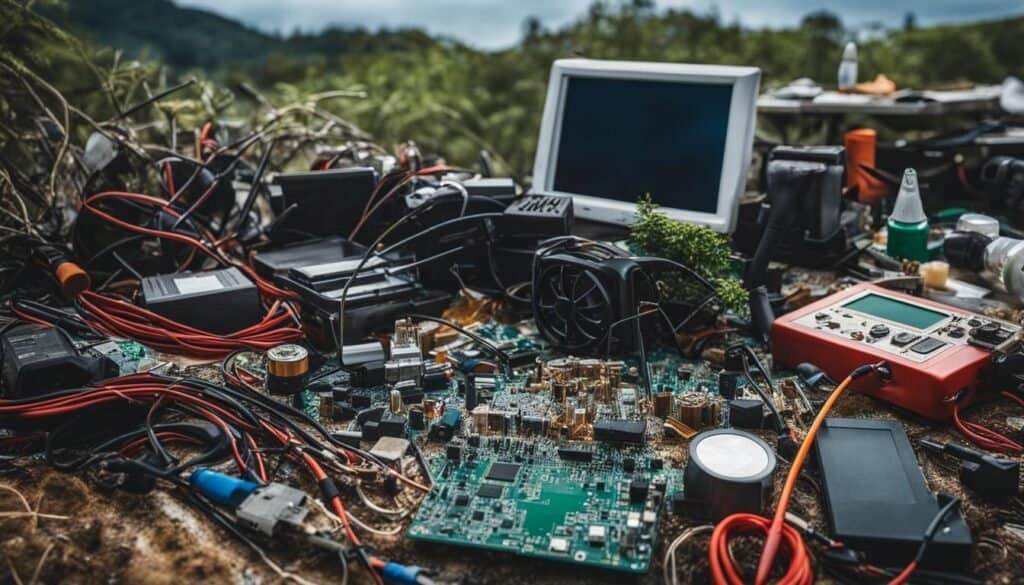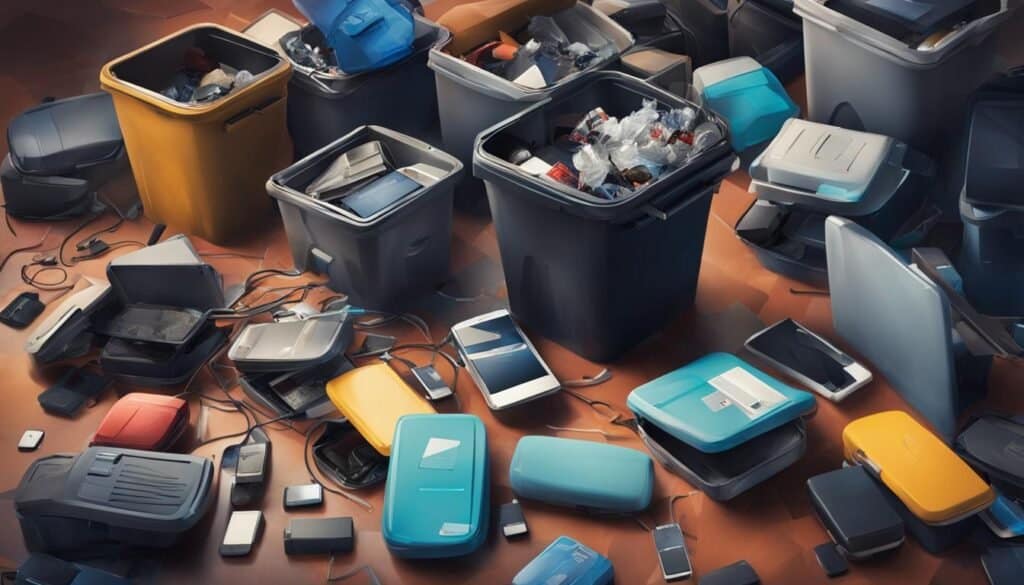In today’s ever-advancing digital age, we often find ourselves surrounded by an increasing number of electronic gadgets. While these devices offer countless benefits, they also contribute to a growing problem: electronic waste, or e-waste. Sustainable e-waste management is essential in reducing the environmental impact of our voracious appetite for new technology. By understanding the need for e-waste recycling and embracing eco-friendly practices, we can make a more significant impact on preserving our planet and its resources for future generations.
As we navigate through the challenges of living in a technology-driven society, it’s crucial to be mindful of the consequences of our consumer habits. The choices we make in purchasing, utilizing, and disposing of our electronics have long-lasting effects on the environment and our communities. By incorporating sustainable habits into our daily lives and raising awareness about the importance of proper e-waste management, we can work together to create a more responsible, eco-conscious digital age.
Key Takeaways
- E-waste is an escalating global problem that requires urgent attention and sustainable solutions.
- Understanding the environmental impact of e-waste helps us make informed decisions about the electronics we choose to buy and how we discard them.
- Both consumers and corporations have a critical role in managing e-waste sustainably through responsible practices and recycling initiatives.
- Repairing, reusing, and recycling electronics can substantially reduce the volume of e-waste generated.
- Educating ourselves and others about proper e-waste disposal and recycling practices is essential for fostering widespread change and creating a greener, more sustainable future.
The Urgency of Addressing E-Waste in Our Digital Era
The global e-waste crisis is escalating, largely fueled by the acceleration of consumer electronics that usher in conveniences and capabilities previously unimagined. With the multitude of smartphones now outnumbering the world’s population and the volume of electronic waste becoming the fastest-growing waste stream
E-waste can be a source of recoverable valuable materials, which, if recycled, can conserve energy equivalent to powering thousands of homes and lower production costs for new devices. As we navigate this digital era, the impetus falls on us to adopt sustainable solutions that address the urgency of proper e-waste management—together, we can cultivate a future where technology works in harmony with our environmental goals.
As we navigate this digital era, the impetus falls on us to adopt sustainable solutions that address the urgency of proper e-waste management—together, we can cultivate a future where technology works in harmony with our environmental goals.
- Recognize the urgency of addressing the global e-waste crisis
- Promote sustainable solutions to manage the growing waste stream
- Seek ways to minimize the environmental footprint of consumer electronics
Understanding E-Waste and Its Environmental Effects
Electronic waste, often referred to as e-waste, spans a range of discarded electrical or electronic devices. These gadgets have become an embedded part of our everyday lives, yet they come with an expiry date, at which point they transition into a different, more problematic role. As our reliance on electronic devices amplifies, so does the potential for harm that discarding them improperly poses.
Defining E-Waste and Its Constituents
E-waste constituents frequently contain toxic chemicals such as lead, mercury, arsenic, and cadmium which, when mishandled, pose substantial dangers to the ecosystem and public health. The e-waste definition encompasses a wide array of devices that have reached the end of their useful life and have been discarded, often without proper consideration for their environmental and health impacts.
The Toxicity of E-Waste Components
Many e-waste components are classified as hazardous waste due to their potential to contaminate the environment with toxic chemicals. Lead, mercury, arsenic, and cadmium are prominent examples of hazardous substances found in various electronic devices. When e-waste is not recycled or handled properly, these substances can pose significant threats not only to the environment but also to human health.
Impact of E-Waste on Soil and Water Systems
When e-waste is not recycled or handled properly, the heavy metals and hazardous chemicals embedded within can leach into the soil and water systems. This contamination poses dire consequences for the environment and human health—drinking water supplies can become tainted, endangering communities and disrupting natural habitats. Properties near e-waste disposal sites may also experience increased presence of toxic runoff, negatively impacting local ecosystems and promoting harmful waste recycling practices.
It’s crucial for both individuals and corporations to understand the potential environmental and health impacts of electronic waste and to adopt sustainable practices to reduce both its production and improper disposal. This collective effort can help to mitigate the hazardous effects of e-waste on our planet and its inhabitants, paving the way towards a greener and more sustainable future.
Empowering Consumers: Strategies for Reducing Electronic Waste Sustainably

As consumers, we wield the power to instigate change and significantly reduce the stream of e-waste generated. Educating ourselves on product lifespans, making environmentally conscious purchases, and embracing recycling can fundamentally alter our patterns of consumption. By buying electronics with longer lifespans and acknowledging our role in a sustainable ecosystem, we can reduce our environmental impact and inspire others within our sphere to follow suit, acting as catalysts for broader societal transformation.
- Research before you purchase: Learn about the product lifecycle, company sustainability practices, and the availability of replacement parts to ensure you are making an ecologically responsible decision.
- Buy refurbished or pre-owned electronics: Purchasing second-hand devices not only saves money but also contributes to reducing the demand for new products, helping to curb the production of electronic waste.
- Maintain and repair your devices: Extend the life of your electronics through proper care, cleaning, and regular maintenance. Seek professional help or perform DIY repairs when necessary.
- Donate or sell working electronics: When upgrading to a new device, consider donating or selling the old one to extend its lifespan and reduce e-waste generation.
- Participate in recycling initiatives: Properly dispose of non-functional devices through certified electronics recyclers, ensuring hazardous materials are safely managed and valuable components are recovered.
Above all, embracing a sustainable mindset entails exercising restraint and assessing our true needs before adding another electronic device to our collection. This shift in consumer behavior is instrumental in promoting a greener and more responsible electronic landscape for future generations to enjoy.
| Reduce | Reuse | Recycle |
|---|---|---|
| Buy refurbished or pre-owned electronics | Maintain and repair your devices | Participate in recycling initiatives |
| Research before making a purchase | Donate or sell working electronics | Support companies with take-back programs |
| Resist the urge to constantly upgrade | Repurpose outdated technology | Use certified electronics recyclers |
Corporate E-Waste Management: A Responsible Approach
Corporations have a profound responsibility in managing e-waste sustainably. By instituting take-back programs, designing with sustainability in mind, and supporting consumer education, companies can greatly contribute to waste reduction and environmental stewardship.
Implementing Take-Back and Recycling Programs
Companies can encourage the return of outdated devices which can then be properly recycled or refurbished through take-back programs. These endeavors reduce the volume of electronic waste, support the cycle of sustainability, and showcase a company’s commitment to corporate responsibility and e-waste reduction.
Designing with the End-of-Life in Mind
Integrating sustainable engineering into product designs enables corporations to influence the e-waste narrative positively. Constructing long-lasting electronics with the end-of-life in mind ensures that once these devices have reached the end of their utility, they can enter recycling streams with greater ease, optimizing the opportunity to reclaim and repurpose valuable materials.
Corporate Stewardship and Consumer Education Initiatives
By spearheading educational initiatives, corporations play a pivotal role in nurturing a culture of environmental stewardship. Corporations that launch campaigns to illuminate the environmental impact of electronic waste contribute significantly to consumer awareness, driving them to engage in more ecologically sound disposal practices.
In summary, companies that embrace their responsibility to manage e-waste sustainably help foster a greener future for all. These efforts not only reduce electronic waste but also set a positive example for consumers and other businesses to follow.
From Purchase to Disposal: Making Smart Decisions to Reduce E-Waste

Electronic devices are ubiquitous in our daily lives, playing a pivotal role in work, education, communication, and entertainment. However, as these devices reach the end of their lifespan, it’s crucial to adopt sustainable e-waste management practices that lessen the environmental impact. From the moment we purchase a device to its eventual disposal, every decision we make contributes to this collective effort.
Before purchasing an electronic product, it’s essential to consider a few factors that will influence its lifespan. Opt for well-established brands or those with a reputation for long-lasting devices, and do some groundwork to gauge the product’s durability, repairability, and energy efficiency. This will help ensure you invest in a device that has a low environmental footprint and can serve you well for an extended period.
While using a device, apply proper maintenance practices to maximize its longevity. Regular updates, storage management, and cleaning can go a long way in extending the lifespan of electronics. By doing so, you not only delay the need for new device purchases but also contribute to combating the e-waste crisis.
When it’s finally time to part with an old device, it’s vital to make informed consumer decisions about its disposal. Contribute to sustainable e-waste practices by recycling at certified centers or donating to reputable organizations.
Understanding the environmental impact of our electronic devices empowers us to make savvy decisions throughout their lifecycle, fostering sustainable e-waste disposal practices that can have a lasting positive effect on our planet.
Becoming aware of relevant regulations and manufacturer take-back programs is also key to ensuring your e-waste is ethically and sustainably managed.
- Research local e-waste disposal regulations to determine proper disposal methods.
- Choose certified recycling centers to ensure that your device will be appropriately recycled or repurposed.
- Consider donating devices that are still functional to charities or schools in need.
As consumers, our choices reverberate along the entire supply chain, guiding industries and shaping the landscapes in which they operate. Adopting prudent consumer decisions and sustainable e-waste disposal practices positively impacts the environment, enabling us to enjoy the conveniences of our gadgets without jeopardizing the well-being of our planet.
Repair and Reuse: Extending the Life of Your Electronics

Emphasizing repair over replacement provides a sustainable alternative to the quick turnover of electronic devices. By mending existing electronics, we not only extend their useful life but also minimize the constant churn of resource-intensive production. In this section, we will explore various resources and strategies that can help us refurbish, reuse, and extend the lifespan of our electronic gadgets, reducing electronic waste and promoting sustainability.
The Case for Repair vs. Replacement
Repairing our devices contributes to their longevity and extends their lifespan, reducing the need to constantly purchase new electronics. This mindset encourages us to be more conscious of the lifetime value of our gadgets, promoting the reuse of electronics and reducing electronic waste. By choosing to repair our devices, we foster a sense of self-sufficiency and embrace sustainability, ultimately making a positive impact on our environment and resources.
Finding Resources for Refurbishment
There are various resources available for refurbishing our electronics, from manufacturers and authorized repair centers to local businesses offering repair and refurbishment services. These resources champion sustainable e-waste solutions and facilitate the extended use of devices, prolonging their functionality while countering the throwaway culture that leads to increased electronic waste. By opting to refurbish our devices, we support a circular economy by enabling their continued use and reducing environmental impact.
Community Workshops and DIY Repair
Community workshops and DIY repair sessions present opportunities for individuals to learn the skills necessary to extend the life of their electronics. These initiatives equip us with the knowledge and skills needed to perform simple repairs on our devices, fostering a sense of self-sufficiency and sustainability. Participating in community workshops and DIY repair events not only empowers us to tackle our own device issues but also encourages a culture of environmental conscientiousness and a shared commitment to reducing electronic waste.
Digital Decluttering: Reducing the Accumulation of Unused Gadgets

As technology advances, it’s easy to amass a collection of unused gadgets. To prevent contributing to the growing issue of e-waste, it’s important to practice digital decluttering, which involves being mindful of our electronic possessions and actively minimizing their accumulation. In this section, we’ll explore strategies for minimizing digital hoarding, responsibly recycling or donating old electronics, and creatively repurposing outdated technology.
Strategies for Minimizing Digital Hoarding
Minimizing digital hoarding starts by implementing organization and decluttering techniques specifically targeted at electronic devices. Develop an inventory of all your gadgets, regularly assess their usefulness, and be disciplined in disposing of devices you no longer need. Embrace a minimalist approach, reducing the number of devices you own, and prioritizing essentials that truly enhance your life.
How to Responsibly Recycle or Donate Old Electronics
One of the major steps in digital decluttering is donating or recycling old electronics instead of throwing them away. Research local organizations that accept device donations, or locate a certified e-waste management facility for responsible recycling. Be sure to follow proper recycling guidelines and data privacy measures by wiping personal data before parting with your devices.
Creative Ways to Repurpose Outdated Tech
Repurposing outdated technology means finding new life for old gadgets. Creative reuse not only averts unnecessary e-waste but also inspires innovation in sustainability efforts. Explore ways to transform your old devices into practical or artistic items, such as turning retired smartphones into security cameras, using idle tablets for digital picture frames, or incorporating electronic components into modern art pieces.
By engaging in digital decluttering, you can take an active role in reducing your electronic waste footprint and fostering a greener, more sustainable digital environment.
The Role of Legislation in Promoting Sustainable E-Waste Practices
Legislative initiatives can significantly impact the promotion of sustainable e-waste practices by establishing rigorous recycling policies and standards. These laws can drive the proper disposal of electronic products, both curbing hazardous waste and incentivizing the recovery of valuable materials.
Among the key elements of e-waste legislation are the enforcement of responsible recycling policy, promotion of sustainable e-waste laws, and upholding high electronics recycling standards. The main goal of these legislative measures is to ensure that e-waste is managed in a manner that mitigates environmental impacts and minimizes health risks for workers involved in recycling processes.
Here is an overview of several successful e-waste legislations around the globe:
| Country | Legislation | Impact |
|---|---|---|
| European Union | Waste Electrical and Electronic Equipment Directive (WEEE) | Established a framework for electronics producers to take responsibility for the collection, recycling, and treatment of e-waste. This has led to a significant reduction in e-waste and increased recycling rates in EU countries. |
| United States | State-level e-waste laws such as California’s Electronic Waste Recycling Act (EWRA) | Implemented e-waste recycling programs, fees, and penalties, which helped reduce the amount of e-waste dumped in landfills and increase recycling rates in states that adopted the laws. |
| Japan | Act on Promotion of Recycling and Related Activities for Treatment of Cyclical Food Resources (The Home Appliance Recycling Law) | Introduced a recycling fee system and mandatory appliance recycling, resulting in higher recycling rates and reduced environmental impact. |
Legislative initiatives can only be effective if there is strong compliance and awareness among stakeholders, including consumers, manufacturers, retailers, and recyclers. As individuals, it is our responsibility to be aware of existing e-waste legislation and support the proper disposal and recycling of electronic products to ensure a more sustainable future for all.
Remember, your electronic devices contain valuable resources that can be recovered and recycled. By adhering to your local e-waste laws and recycling policies, you help preserve our environment and contribute to a more sustainable world.
Recycling E-Waste: Navigating Challenges and Embracing Solutions
While e-waste recycling efforts have made significant strides in recent years, there are still numerous challenges that need to be addressed to accelerate their adoption and create a more sustainable approach to managing electronic waste. By raising awareness, identifying certified recyclers, and offering incentives, we can contribute to a better future for both our planet and future generations.
The Current State of E-Waste Recycling Efforts
Despite the progress made in e-waste recycling efforts, many obstacles continue to hinder the widespread adoption of sustainable practices. Disposal challenges and recycling infrastructure limitations are some of the primary barriers that need to be overcome to foster more responsible e-waste management. By acknowledging these challenges, we can begin to develop strategies that address the root causes and cultivate a more sustainable approach to e-waste reduction.
Identifying Certified Electronics Recyclers
One crucial aspect of proper e-waste disposal is working with certified electronics recyclers. These organizations have obtained e-recycling certification, which ensures they follow responsible practices that protect both the environment and human health. By supporting and promoting certified recyclers, we can help guarantee that our discarded electronics are being managed in a manner that aligns with our sustainability goals.
Improving Recycling Rates Through Awareness and Incentives
Education and incentives play a vital role in increasing e-waste recycling rates. By participating in awareness campaigns that highlight the importance of responsible e-waste management, we can equip individuals with the knowledge required to make informed decisions about their electronic waste disposal practices. Additionally, offering recycling incentives, such as discounts on new products, can further motivate individuals to adopt more eco-friendly habits and contribute to a greener future.
Personal Data and E-Waste: Ensuring Information Security
As our society becomes increasingly interconnected, the intersection of personal data protection and the management of e-waste has become more critical than ever. With the rapid turnover of electronic devices and the potential for sensitive information to be exposed, information security must remain a top priority when disposing of unwanted gadgets.
One of the primary concerns when managing the disposal of electronic devices is protecting personal data. Devices such as smartphones, tablets, and computers store a wealth of sensitive information that can easily fall into the wrong hands if not handled correctly. To ensure proper personal data protection, individuals and businesses alike must take steps to implement secure recycling practices and effective data destruction methods.
The process of data destruction is vital for maintaining information security when disposing of e-waste. This includes:
- Wiping hard drives and other storage media
- Destroying physical devices that contain sensitive data
- Engaging professional services for secure disposal
By employing these measures, individuals and businesses can safeguard their sensitive information from being compromised. This focus on data protection is particularly important when working with certified e-waste recycling companies. Utilizing secure recycling practices ensures the thorough destruction of any stored data on electronic devices, thereby minimizing the risk of data breaches and identity theft.
The growing prominence of e-waste in our digital age underscores the importance of proactive measures in protecting sensitive data. As we work towards a sustainable future, striking a balance between the efficient disposal of electronic waste and safeguarding personal information remains a critical task. By emphasizing information security, personal data protection, data destruction, and secure recycling practices, we can make great strides in managing e-waste responsibly.
Reducing Electronic Waste Sustainably
In our fast-paced world, reducing electronic waste starts with incorporating eco-friendly products into our daily routines and transitioning to a more sustainable lifestyle. By choosing environmentally designed gadgets, we can minimize our environmental footprint while enjoying the conveniences of the digital age.
Incorporating Eco-Friendly Products into Your Routine
One way to embrace a sustainable daily routine is to adopt eco-friendly products. Make conscious choices when purchasing electronic devices by considering their eco-design, energy efficiency, and recyclability. This not only reduces your environmental impact but also supports the development of sustainable technology.
Leveraging Technology for a Sustainable Future
As technology advances, we have the opportunity to harness future-oriented strategies that prioritize sustainability and promote green technology. Embracing tech innovation with environmental responsibility in mind can help create eco-conscious products that contribute to a greener future for our planet.
Balancing Tech Innovation with Environmental Responsibility
Maintaining a balance between technological innovation and environmental responsibility is crucial for achieving a sustainable relationship with our gadgets. By being mindful of the environmental impact of our electronic devices and supporting companies that advocate for sustainability, we can help to drive the growth of green technology and protect our planet for future generations.
Conclusion on Reducing Electronic Waste Sustainably
As we navigate the complex challenge of reducing electronic waste sustainably, it is crucial to remember that integrating sustainable habits into our everyday lives begins with personal responsibility and extends to collective action. By adopting green habits and advocating for environmental stewardship, we contribute to a ripple effect of sustainable practices that can transform our world.
Integrating Sustainable Habits into Everyday Life
Individual actions contribute to the larger collective effort to address e-waste sustainably. Encouraging dialogue and community involvement leads to more significant impacts that reverberate well beyond singular actions. By practicing responsible e-waste management and sharing our knowledge with others, we can create a community of environmental activists working towards a greener digital landscape.
Encouraging Collective Action for Greater Impact
As environmental awareness grows, more people and organizations are realizing the importance of making environmentally friendly technology choices. Through collaboration and collective action, we can make a greater impact on reducing electronic waste and steering towards a sustainable future. Maintaining open conversations and fostering partnerships between consumers, corporations, and legislators are essential in achieving ecological sustainability.
Moving Towards a Greener Digital Landscape
Our journey towards a greener digital landscape is a shared responsibility, requiring the concerted efforts of consumers, corporations, and legislators alike. It is through the fusion of their initiatives that we can pave the way for a future where technology and ecological sustainability are interwoven, fostering a harmonious relationship between human progress and environmental preservation. Together, we can create a world where technological advancements coexist with our commitment to safeguarding the health of our planet and its inhabitants.
FAQ on Minimize Electronic Waste
Q: What is e-waste?
A: E-waste refers to electronic products that have been discarded, including anything with a battery or a cord.
Q: How does e-waste impact the environment and health?
A: E-waste can release toxic materials when improperly handled, leading to environmental pollution and health risks for those exposed to the toxins.
Q: What are the consequences of e-waste?
A: Consequences of e-waste include soil and water contamination, as well as negative impacts on human health due to exposure to hazardous materials.
Q: How can we reduce e-waste sustainably?
A: By extending the lifespan of electronic devices, responsibly recycling electronics, and supporting sustainable e-waste management practices, we can reduce e-waste sustainably.
Q: What are some sustainable approaches to e-waste management?
A: Sustainable e-waste management involves proper recycling, refurbishment, and reuse of electronic equipment, in addition to promoting responsible end-of-life practices.
Q: Why is it important to reduce e-waste?
A: Reducing e-waste is crucial to minimize environmental impact, decrease the release of greenhouse gas emissions, and preserve natural resources.
Q: What are some ways to reduce e-waste effectively?
A: Effective e-waste reduction methods include promoting electronics reuse, supporting recycling programs, adopting eco-friendly consumption habits, and advocating for e-waste regulations.
Q: What should I do with my old electronic gadgets?
A: You can consider donating, repurposing, or recycling your old electronic gadgets to extend their lifespan and prevent them from becoming waste.
Q: Where can I find certified e-waste recyclers?
A: Look for environmentally responsible e-waste recyclers certified by organizations such as the EPA to ensure proper and sustainable e-waste management.
Q: How can I get involved in sustainable e-waste initiatives?
A: You can participate in e-waste collection events, support initiatives aimed at reducing e-waste, and educate others about the importance of sustainable e-waste management.





Leave a Reply